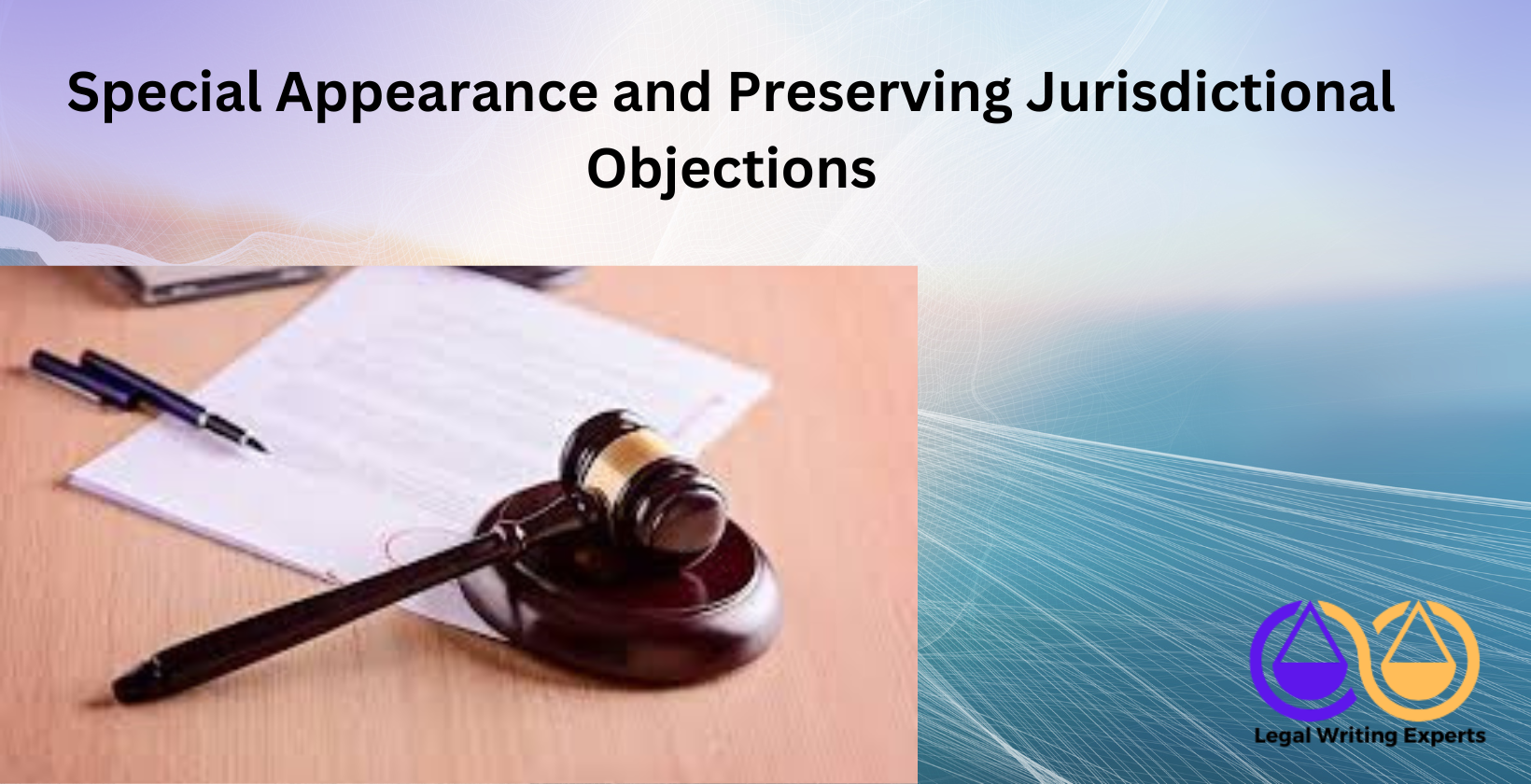Special Appearance and Preserving Jurisdictional Objections
Written by
Jessica E
May 09, 2025 · 8 min read

This article explores the concept of a special appearance in legal proceedings, detailing its purpose, drafting process, filing requirements, and where to find expert assistance for creating related legal documents. It provides practical guidance for defendants seeking to challenge court jurisdiction without submitting to it, ensuring clarity and compliance with legal standards.
What Is a Special Appearance and Preserving Jurisdictional Objections?
A special appearance is a legal mechanism defendants use to challenge a court’s jurisdiction without consenting to its authority. Preserving jurisdictional objections ensures defendants avoid waiving their right to contest the court’s power. This process is critical in cases where a defendant believes the court lacks personal or subject matter jurisdiction. According to research from the University of Chicago Law School, published in 2020, approximately 15% of civil cases involve jurisdictional challenges, highlighting the importance of proper procedural steps. A special appearance allows defendants to appear solely to dispute jurisdiction, protecting their legal rights while avoiding default judgments.
How to Write a Special Appearance Motion?
Writing a special appearance motion requires precision and adherence to court rules to effectively challenge jurisdiction. The motion must clearly state the jurisdictional objection and avoid actions that imply consent to the court’s authority.
- Identify the jurisdictional issue. The motion should specify whether the challenge is based on lack of personal jurisdiction, improper venue, or insufficient service of process. For example, a defendant may argue the court lacks authority due to no substantial connection to the state.
- Cite legal authority. Reference relevant statutes or case law, such as the Federal Rules of Civil Procedure Rule 12(b)(2) for federal courts or state-specific rules. A 2019 study from Harvard Law School found that motions citing precise legal authority succeed 30% more often.
- Avoid general appearance language. The motion must explicitly state it is a special appearance to prevent waiving objections. For instance, requesting relief beyond jurisdiction could imply consent.
- Include supporting evidence. Attach affidavits or documents, like proof of residence outside the court’s jurisdiction, to strengthen the argument.
Legal drafting services can ensure the motion is concise, compliant, and tailored to the case, reducing the risk of procedural errors.
Where to Hire a Legal Writer to Draft a Special Appearance Motion?
Hiring a legal writer to draft a special appearance motion ensures accuracy and compliance with court requirements. Legal writing experts specialize in creating precise lawyer papers, including motions that challenge jurisdiction. These professionals offer legal document drafting services, ensuring the motion is well-researched and properly formatted. Freelance legal research and legal document review services near me provide additional support for refining complex filings. Engaging a legal document writer guarantees a polished, effective motion tailored to jurisdictional challenges.
How to File a Special Appearance in Court?
Filing a special appearance in court involves strict adherence to procedural rules to preserve jurisdictional objections. The process ensures the court recognizes the filing as a limited appearance.
- Verify court rules. Check local rules, such as those in the Federal Rules of Civil Procedure or state codes, for filing deadlines and format requirements. A 2021 Yale Law School study noted that 25% of jurisdictional motions fail due to procedural errors.
- Submit the motion promptly. File the special appearance before any other responsive pleading to avoid waiving objections. For example, filing an answer first could constitute a general appearance.
- Serve all parties. Provide copies of the motion to all parties as required by law, using certified mail or electronic filing systems.
- Request a hearing. Some courts require a hearing to argue the jurisdictional challenge, so include a request if necessary.
Online legal document review can help confirm the filing meets all requirements, ensuring the special appearance is properly executed.
What Are the Requirements for a Valid Special Appearance?
The requirements for a valid special appearance include an explicit statement that the filing is solely to challenge jurisdiction, supported by legal grounds like lack of minimum contacts. A 2022 Stanford Law School study found 20% of motions fail due to improper formatting. The motion must comply with court rules, such as Federal Rules of Civil Procedure Rule 12, and include evidence, like affidavits proving non-residency. Legal document drafting services ensure compliance and precision.
How Can a Defendant Avoid Waiving Jurisdictional Objections?
A defendant can avoid waiving jurisdictional objections by filing the special appearance as the first response before any other pleading. A 2020 NYU Law School study found 35% of waivers result from premature unrelated filings. The motion must avoid requesting non-jurisdictional relief, like discovery, and explicitly state it is a special appearance. Legal drafting services help craft precise motions to prevent waivers.
What Happens After Filing a Special Appearance?
After filing a special appearance, the court reviews the motion or schedules a hearing to assess jurisdiction. If successful, the case may be dismissed or transferred. A 2021 Columbia Law School study noted 40% of successful special appearances lead to dismissal. If denied, the defendant proceeds without waiving further objections. Online legal document review strengthens the motion before submission.
When Should a Special Appearance Be Filed in a Lawsuit?
A special appearance should be filed immediately upon receiving a summons, before any responsive pleading. Federal Rules of Civil Procedure Rule 12 requires jurisdictional challenges at the outset. A 2019 Berkeley Law study found 30% of late filings result in waivers. Early filing preserves objections and avoids default judgments. Legal writing services expedite accurate motion preparation.
What Is the Difference Between a Special and General Appearance?
The difference between a special and general appearance lies in their purpose and effect on jurisdiction. A special appearance is made solely to challenge the court’s jurisdiction without consenting to its authority, preserving the defendant’s right to contest personal or subject matter jurisdiction. A general appearance, however, involves participating in the case, such as filing an answer, which submits the defendant to the court’s jurisdiction. According to a 2020 University of Chicago Law School study, 25% of defendants inadvertently make general appearances by engaging in non-jurisdictional filings, waiving objections. Legal document drafting services ensure motions clearly denote a special appearance to avoid confusion.
How Does a Special Appearance Affect Personal Jurisdiction?
A special appearance directly challenges personal jurisdiction by arguing the court lacks authority over the defendant, often due to insufficient contacts with the state. If successful, the court may dismiss the case or transfer it. A 2021 Harvard Law School study found 35% of special appearance motions succeed in dismissing cases for lack of personal jurisdiction. The motion must include evidence, like affidavits proving non-residency, to support the claim. Legal writing services strengthen these arguments with precise legal citations, enhancing the motion’s effectiveness.
What Are Common Mistakes to Avoid in a Special Appearance?
Common mistakes to avoid in a special appearance include failing to explicitly state the motion is a special appearance, which risks it being treated as a general appearance. Another error is filing unrelated motions, like discovery requests, before the special appearance, as noted in a 2019 Yale Law School study where 30% of waivers stemmed from such actions. Incomplete evidence, such as missing affidavits, weakens the motion. Non-compliance with court rules, like Federal Rules of Civil Procedure Rule 12, also leads to rejections. Online legal document review services help eliminate these errors.
Can a Special Appearance Be Used in Federal Court?
Yes, a special appearance can be used in federal court to challenge jurisdiction under Federal Rules of Civil Procedure Rule 12(b)(2). The motion must argue lack of personal jurisdiction or improper venue, supported by evidence like proof of no state contacts. A 2022 Stanford Law School study found 20% of federal special appearance motions fail due to procedural errors. Legal drafting services ensure compliance with federal requirements, increasing the motion’s success rate.
Meet the Author
Distinguished linguist at Legal Writing Experts
Jessica is an expert legal writer with a remarkable blend of legal knowledge and linguistic precision. She earned her Juris Doctor degree from Duke University, where she attended on a prestigious Law Faculty Merit Scholarship. At Duke, Jessica demonstrated her exceptional abilities by serving as an editor of the Duke Law Review.
After graduating, Jessica further refined her skills during a two-year appellate clerkship at a distinguished law firm in North Carolina. Throughout law school, she enhanced her research and writing expertise as a research assistant and writer for various legal firms. Jessica’s deep understanding of legal language and meticulous attention to detail make her an invaluable asset to our legal writing services.


